February 6, 2012 |
BITE: My Journal
Bites Big and Small at Caffé Storico
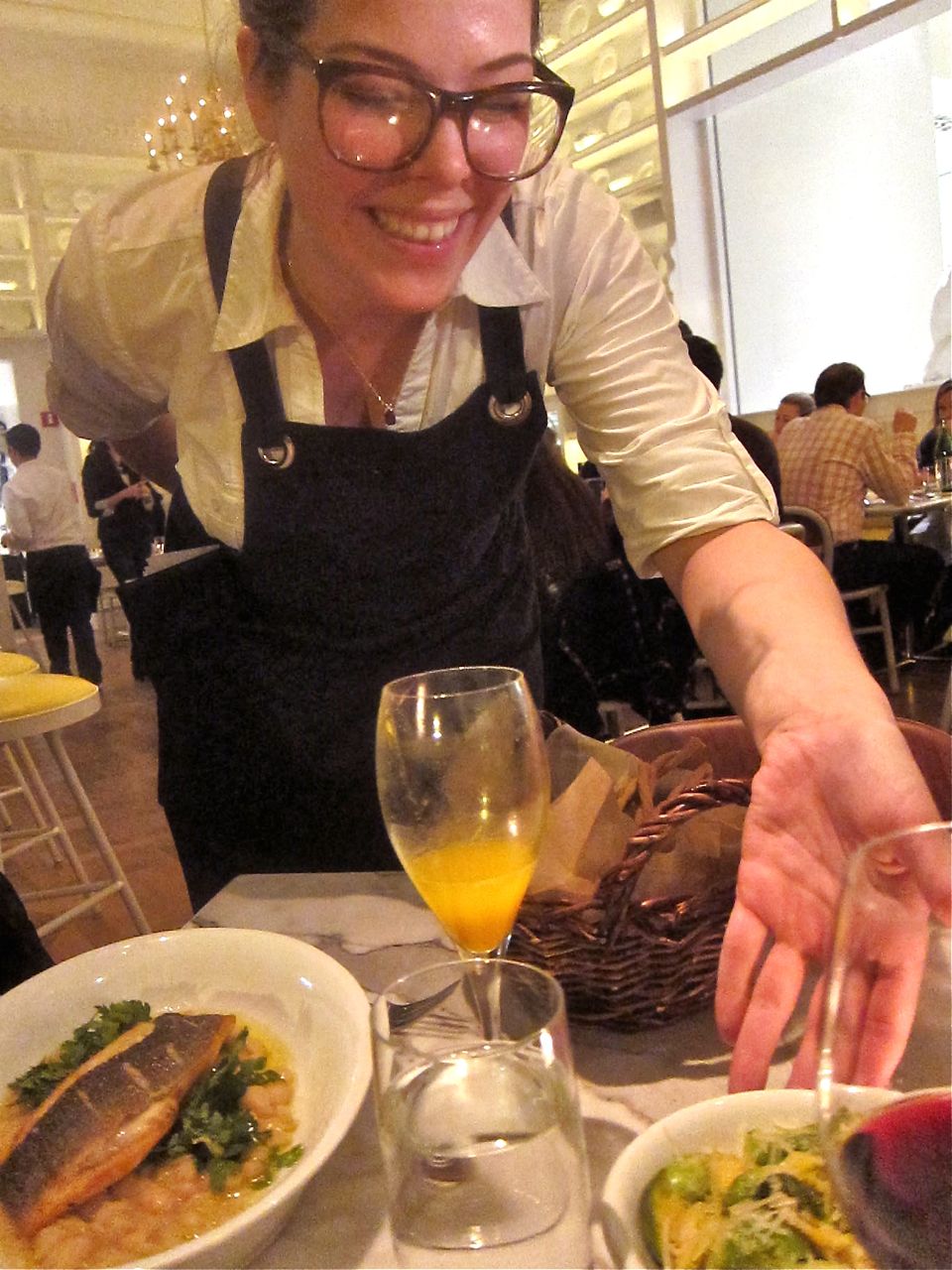
Are the servers slightly high on the sunniness of the room? I wonder. Photo: Gael Greene
Hitching a cultural rock to a restaurant rock star isn’t new. MOMA gets major buzz from The Modern, by Danny Meyer with Gabriel Kreuther at the range. Even Meyer’s perversely unnamed “Untitled” lends cachet to the Whitney. But it needn’t be the Shake Shack Titan himself. Ronald Lauder’s Neue Museum draws sacher torte fans for lunch at Café Sabarsky. The Museum of Arts and Design has its second iteration of Robert looking out over Columbus Circle. There’s nothing like a restaurant with credentials to boost income when the galleries shut down at night.
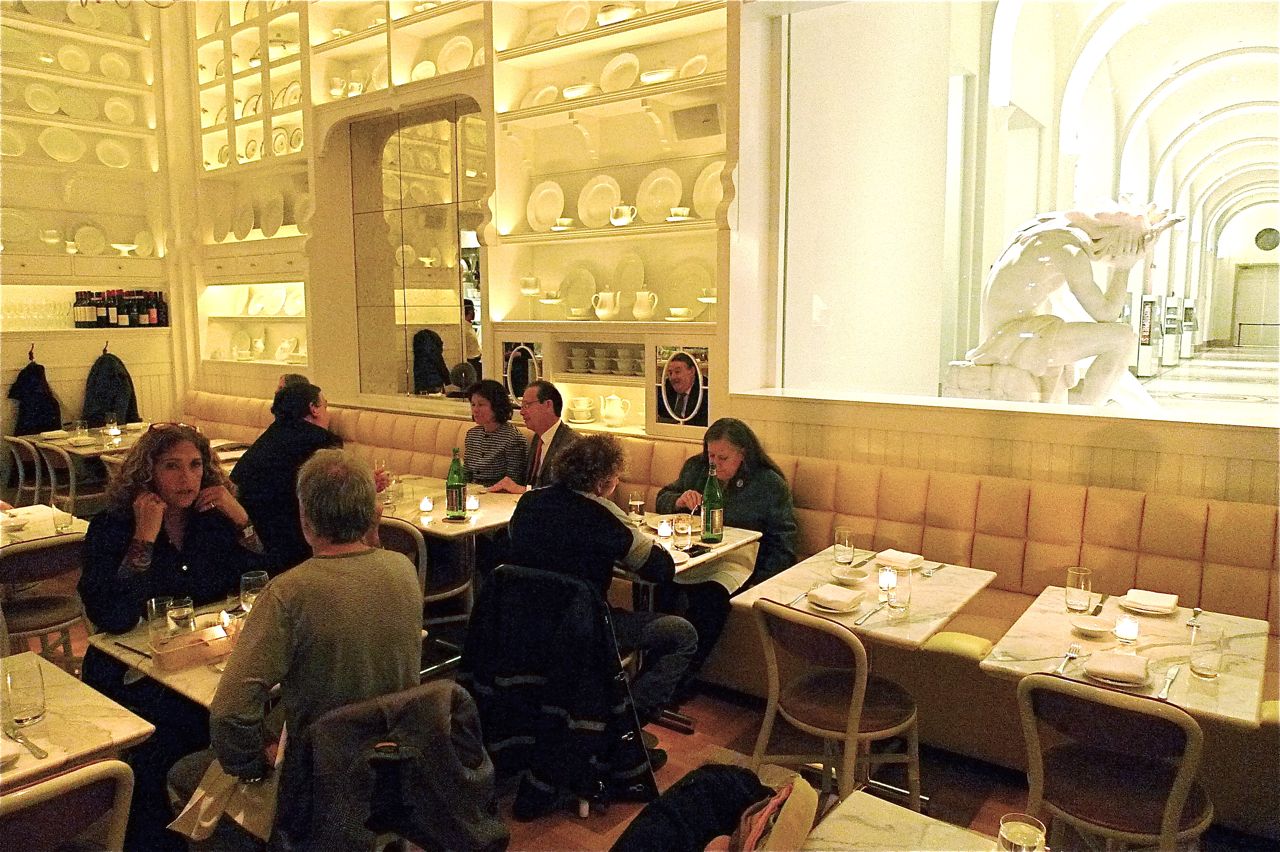
Through a glass: light and an Indian sculpted in marble. Photo: Steven Richter
Having poured $65 million into a major gussying up, it makes sense that the New-York Historical Society – the city’s oldest museum – would move to upgrade its feeding. I can’t say why Danny Meyer wasn’t the designated driver here. Maybe he was too busy establishing a feeding beachhead in Battery Park. Or maybe he didn’t want to compete with himself at Shake Shack two blocks away.
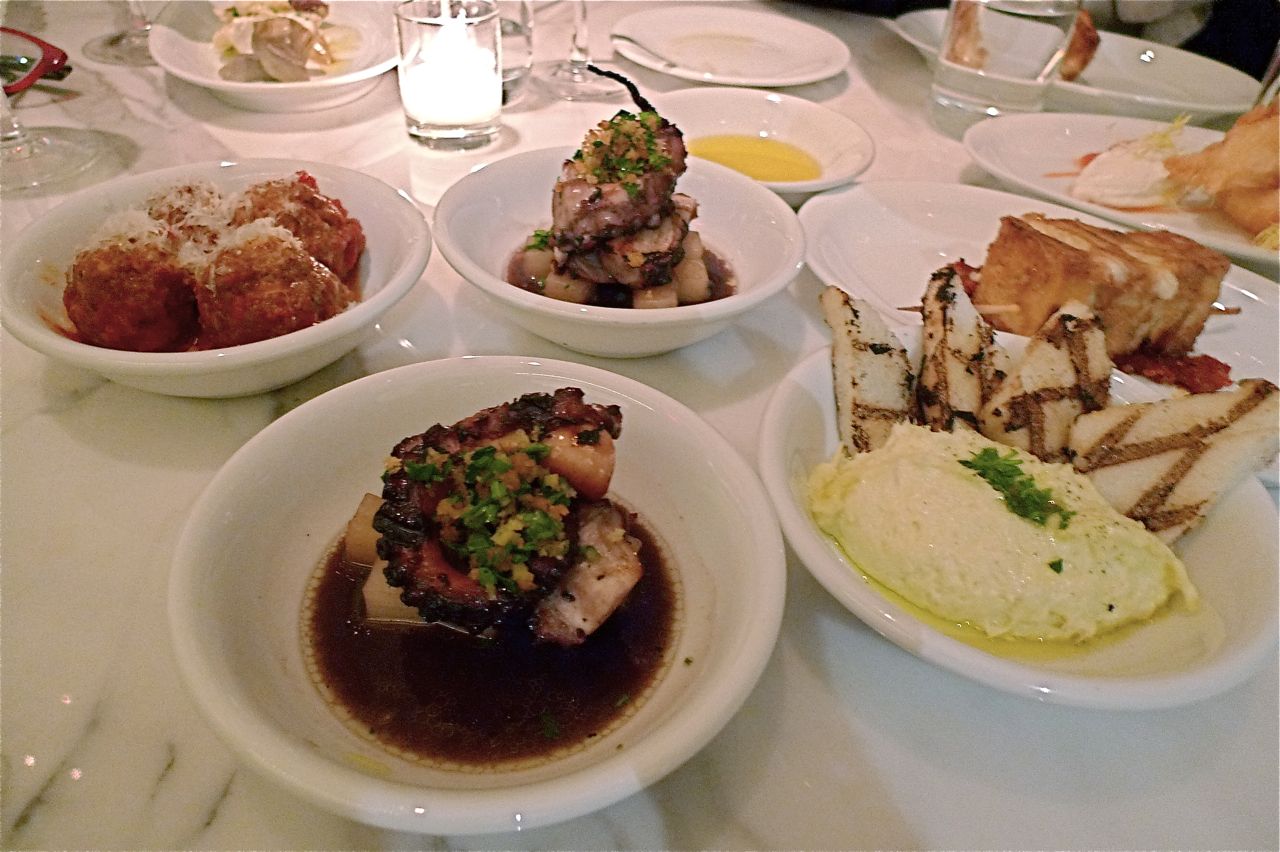
From left: meatballs, octopus and whipped baccala with polenta. Photo: Steven Richter
Step in Stephen Starr, Philadelphia restaurant biggy, with Manhattan scores already at Buddakan and Morimoto. Since he announced in 2010 he was trolling for restaurant space in New York – not one or two spots, but several – Caffé Storico seems almost modest as a next move. Still, it’s a stunner, with a casual, dazzling sunniness that might make you feel you’ve stepped out of time. And the kitchen has its moment: lush buttery burrata with artichoke two ways, splendid minestrone, house-made pastas dressed in savory, creative strokes.
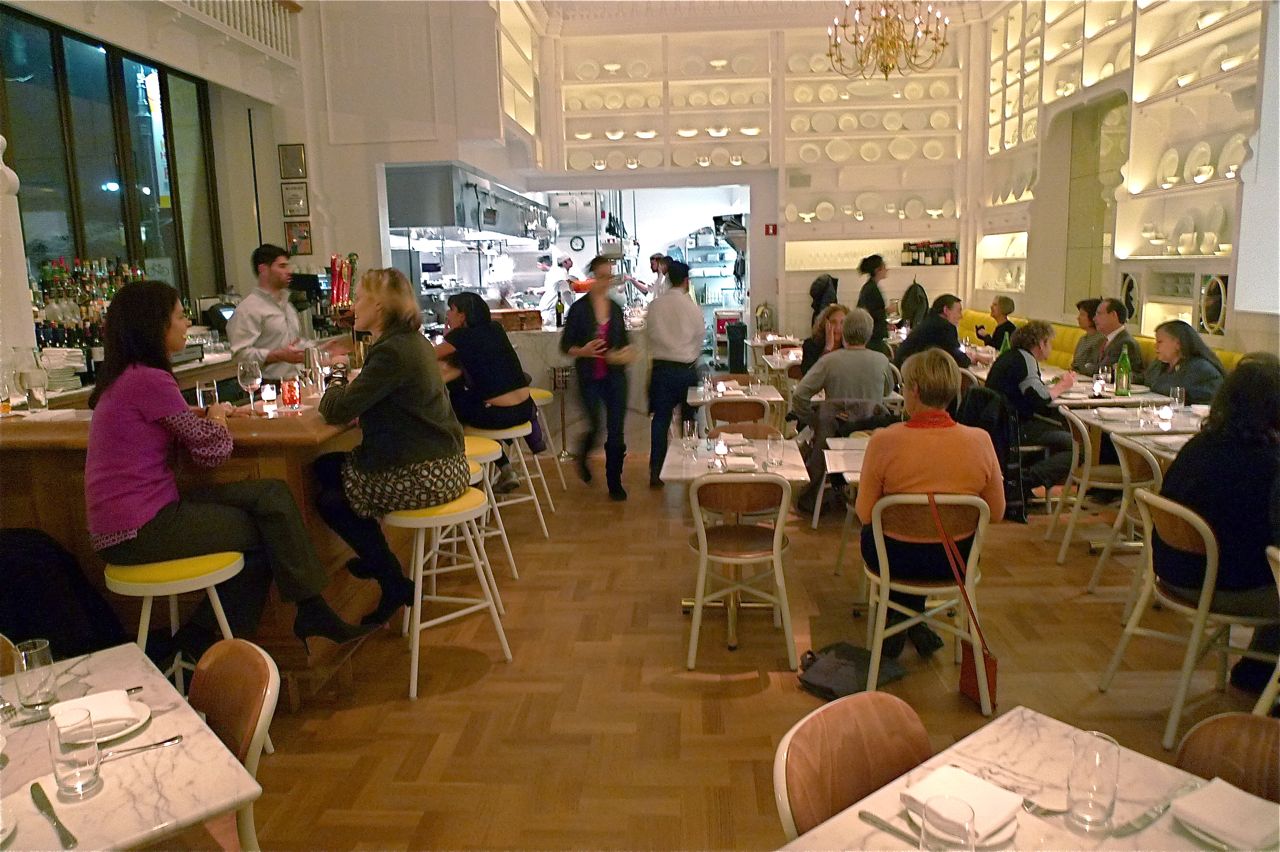
Beyond the cicchetti bar is the open kitchen. Photo: Steven Richter
I’ve lived less than half a mile away for 40 years and I’ve never been inside the Historical Society. The uplifted building fairly glows now on its corner of Central Park West and 77th. On entering – with a hug for the unresponsive Frederick Douglass in bronze stationed on the porch landing – my eyes are drawn to the gift shop. Closed. And then…a sunny yellow glow opposite: The airy sweeping space with its open kitchen at the rear. Shiny brass chandeliers dangling from 15 foot ceilings. A collection of 19th century porcelain and Staffordshire china on surrounding shelves. A marble cicchetti counter, with few takers at 9 pm.
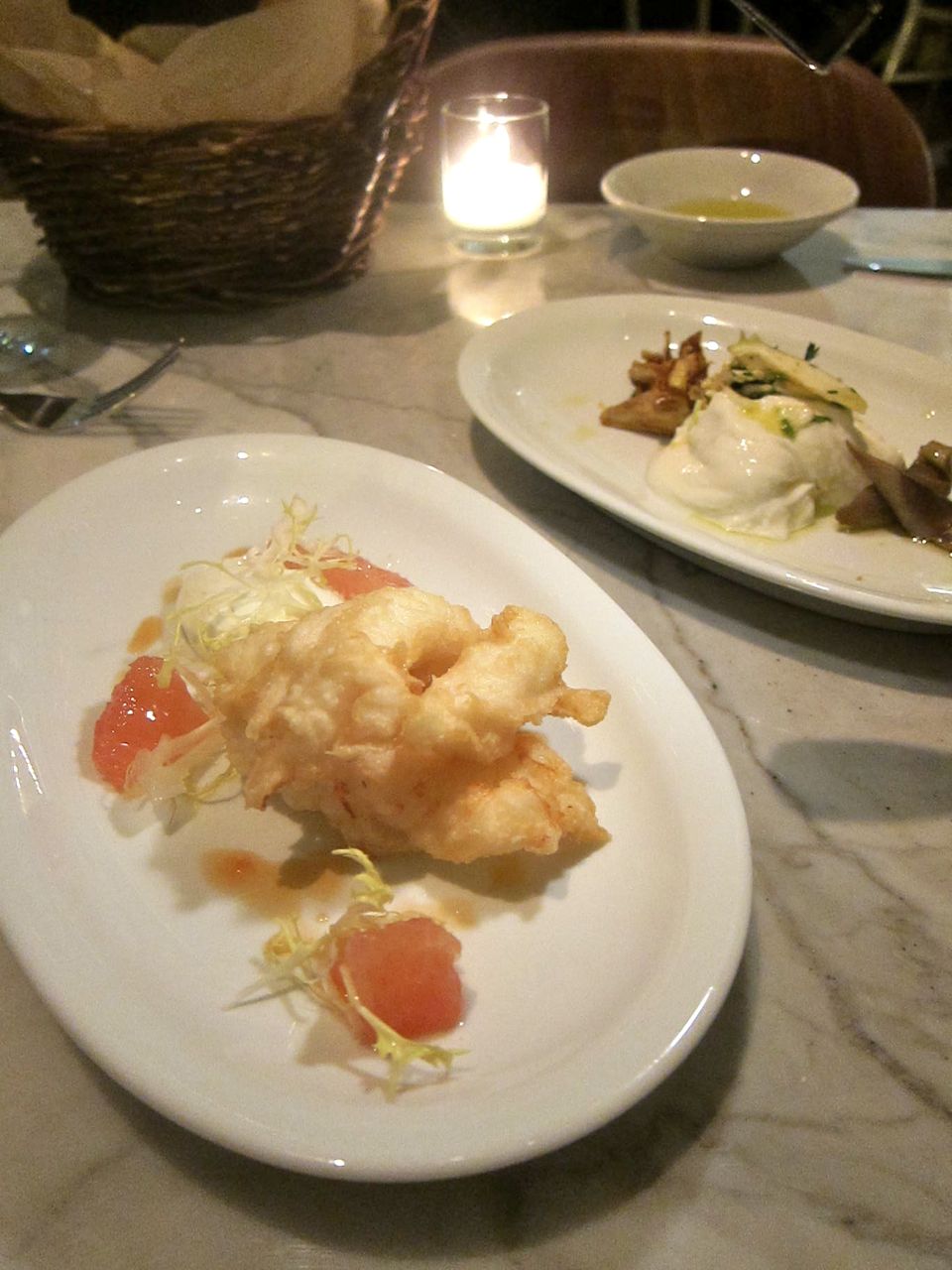
Langoustino fritters with ricotta; top: burrata and artichokes. Photo: Steven Richter
Bare white marble tables are pulled up to a 30 foot yellow leather banquette, amazingly comfortable. Big windows frame the Museum of Natural History across the street. And a large interior window opens into a gallery, revealing the muscled back and feather headdress of a bigger-than-life marble Indian.
“Anyone we know?” I ask the hostess. She bustles off to find out, returning with “The Dying Chief Contemplating the Progress of Civilization,” by Thomas Crawford, scrawled on a Cafe postcard. Kind of a funky title for 1856. It must be a joke.
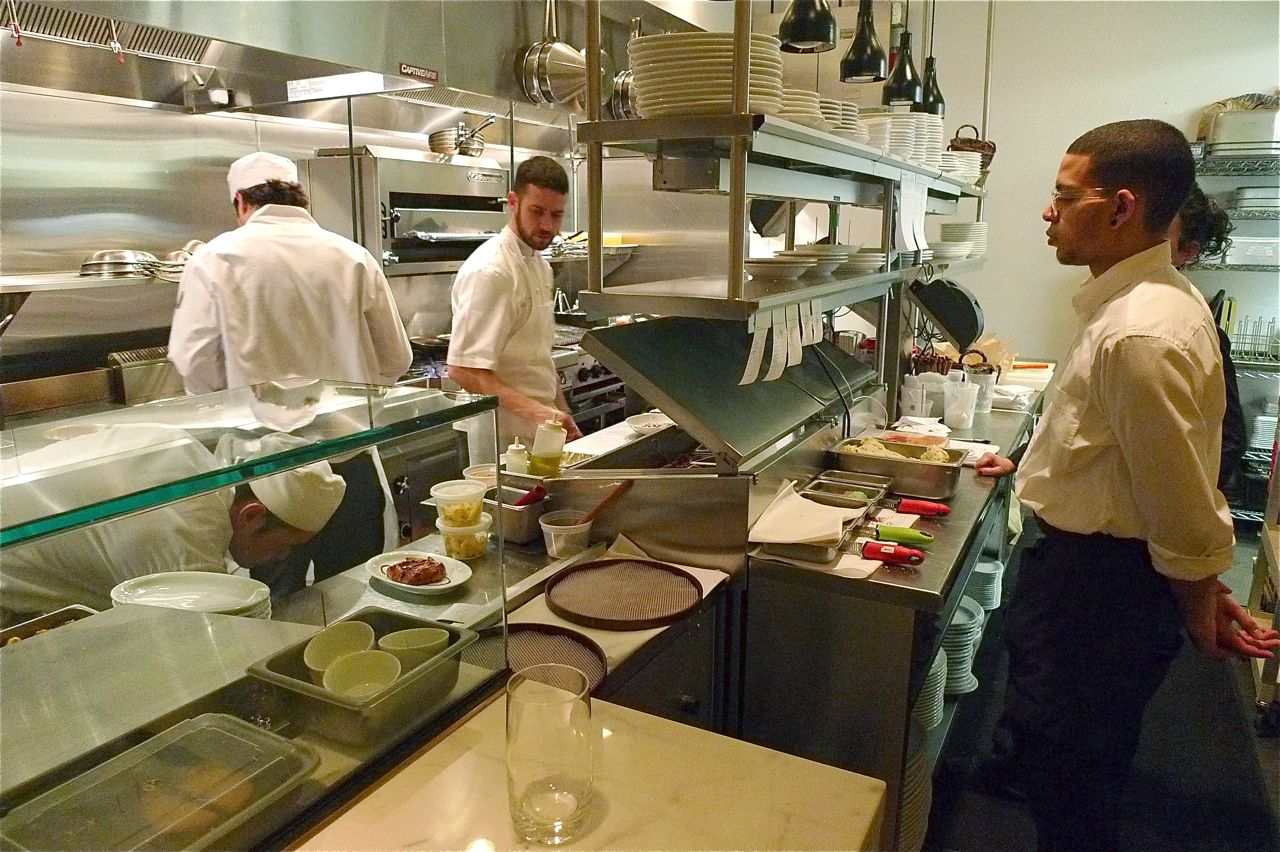
That’s chef Jim Burke, an import from Philly, hatless in a Monday lull. Photo: Steven Richter
But the room is a joy. I don’t need a flashlight to read the menu! It’s noisy but I can hear without shouting! A relay of staff is welcoming, enthusiastic, almost kicky and definitely flakey. Are they high? I ask myself. Maybe just having a job in this cheerful place does it. Alas, delivery from the kitchen is slow even on an uncrowded Monday. Too soon we’ve exhausted the house-made breadsticks.
Eventually, cicchetti tasting plates from the spottily Venetian menu are crowding our table: marvelous whipped cod (baccala mantecato) with triangles of fried polenta, battered scampi with a ricotta fluff and pink grapefruit, and decent meatballs in tomato sauce ($3 extra for the 4th meatball).
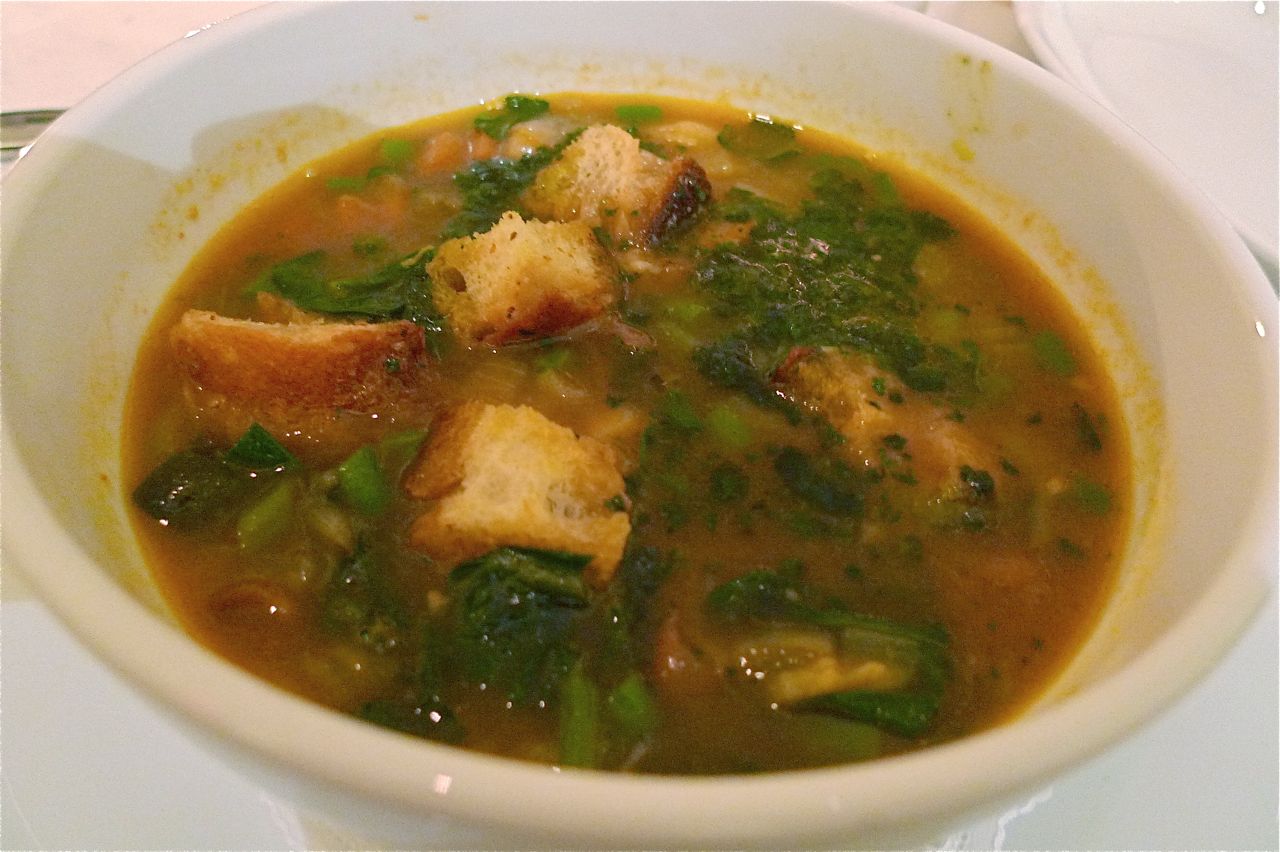
The minestone has depth and root vegetable freshness. Photo: Steven Richter
The octopus (“Beaten into tenderness by the chef,” our waiter boasts) is mealy, a few dishes are too salty, the veal tartare excessively so, mozzarella in carrozza not cheesy enough. But the minestrone with pesto crostini is deep and rich. I’m startled and then excited by the lush tangle of flavors dressing hand-made curls of gargenelli pasta: creamy cauliflower, pine nuts and a scant hint of bottarga (mullet roe). Briefly I consider hoarding it. Some of my companions have flatly rejected the idea of fish roe. But we’re committed to trade and taste. Again, for every kitchen score, there’s a miss. Rigatoni with sausage ragu is good enough. The risotto is a soupy porridge with a wonderfully heady scent of wild mushroom and balsamic. A breast of chicken is salty and overcooked. But my friend Bob is making loud smacking noises over the roasted potatoes. “These could be my dinner.” I agree.
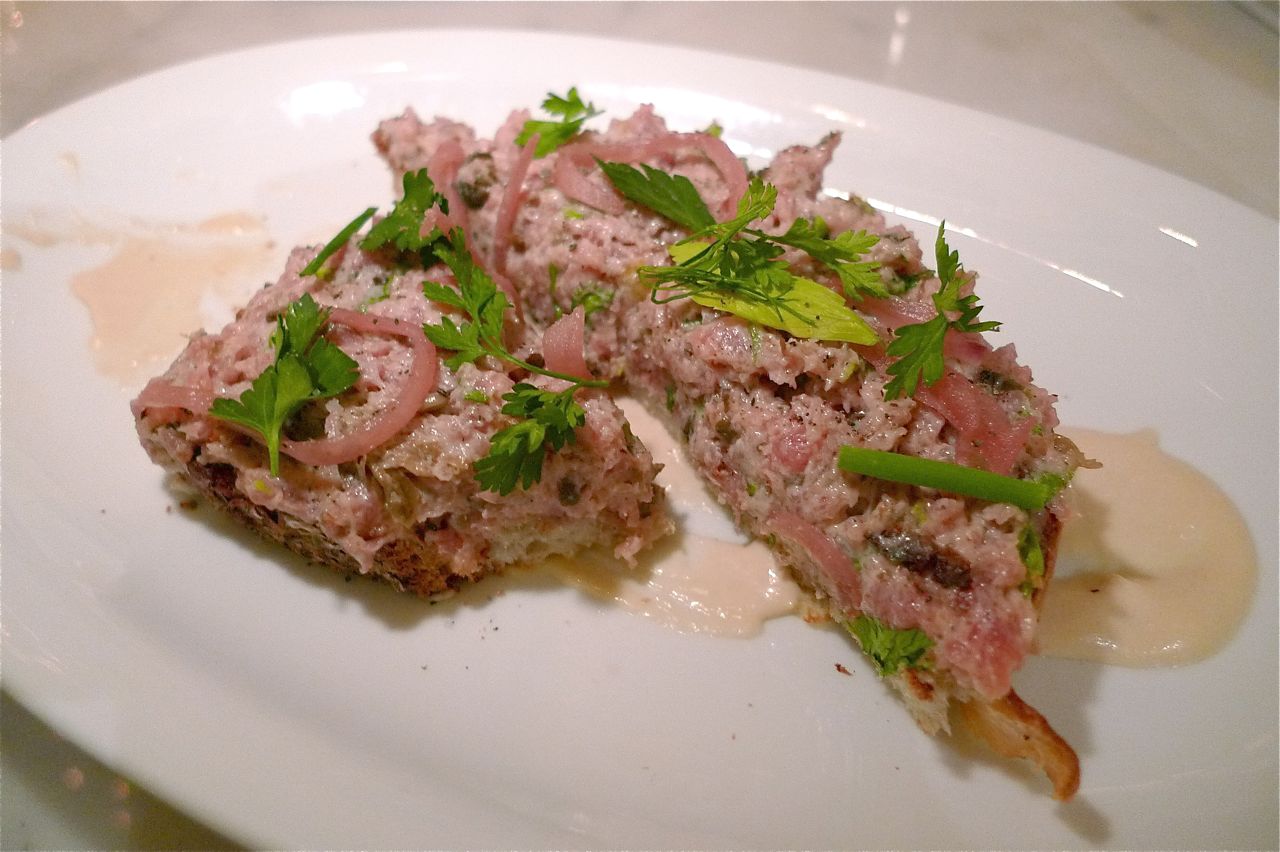
Even our salt-freaks lament the saltiness of this veal tartare. Photo: Steven Richter
“I don’t care that it’s so uneven,” Bob says. “I love this room. And Stephen Starr is a pro. I’m sure he’ll fix this place.”
A veteran of the Starr fiefdom conscripted for Manhattan duty, chef Jim Burke, last at Philly’s upscale James, is rueful when I reach him by phone. “Consistency is the biggest challenge,” he says. “I wasn’t around during the hiring,” he confides. “The turnover of staff in the kitchen and dining room has been constant. I spend so much time training. But we’re starting to get there.”
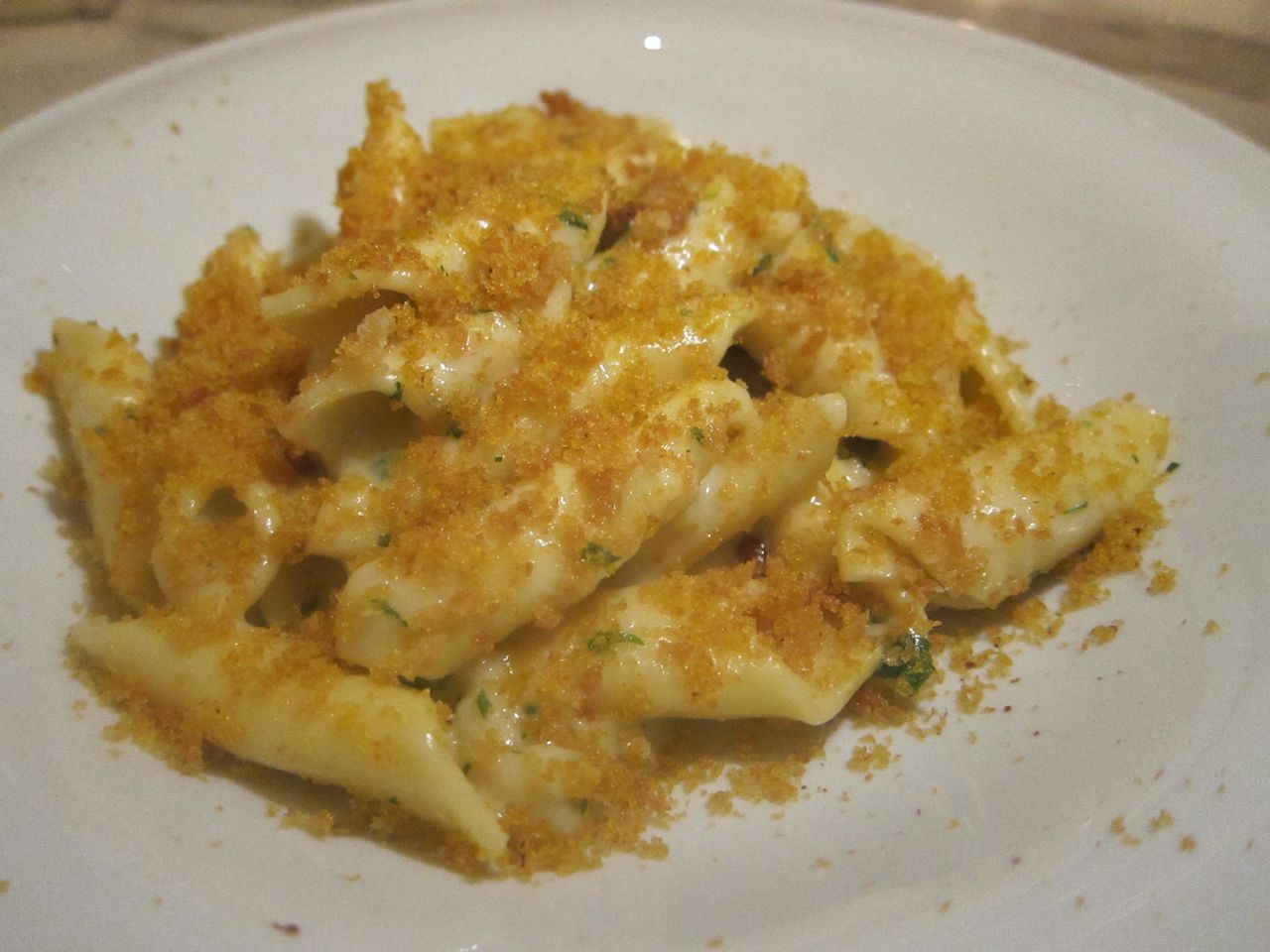
I hope this garganelli dish stays on the menu till I get back. Photo: Gael Greene
Saturday night, we’re back with a friend, dipping those addictive fennel breadsticks – tonight they’re twisted - into a saucer of olive oil. What looks at first like a cushion on my chair is wood – an unlikely hostility in the caress of this space. The house is packed with what looks like an Upper West Side posse. I treat our companion to the scampi fritters I loved and a small $6 shrimp salad sandwich (tramezzini) that wouldn’t make it at half the price in Venice. Nor will acorn squash ever take the place of peach puree in my Bellini, but our guest seems charmed by the seasonal quirk. The service is definitely less erratic.
My guy, a fussy pasta lover, seems happy enough with pleasant-enough lobster-tossed ricotta cavatelli, though he’s left behind many strands of slivered black trumpet mushrooms as he passes it to me. Chocolate is deftly muted in the duck ragu on pappardelle. Our sea bass is perfect –“slightly underdone,” I instructed - though salty.
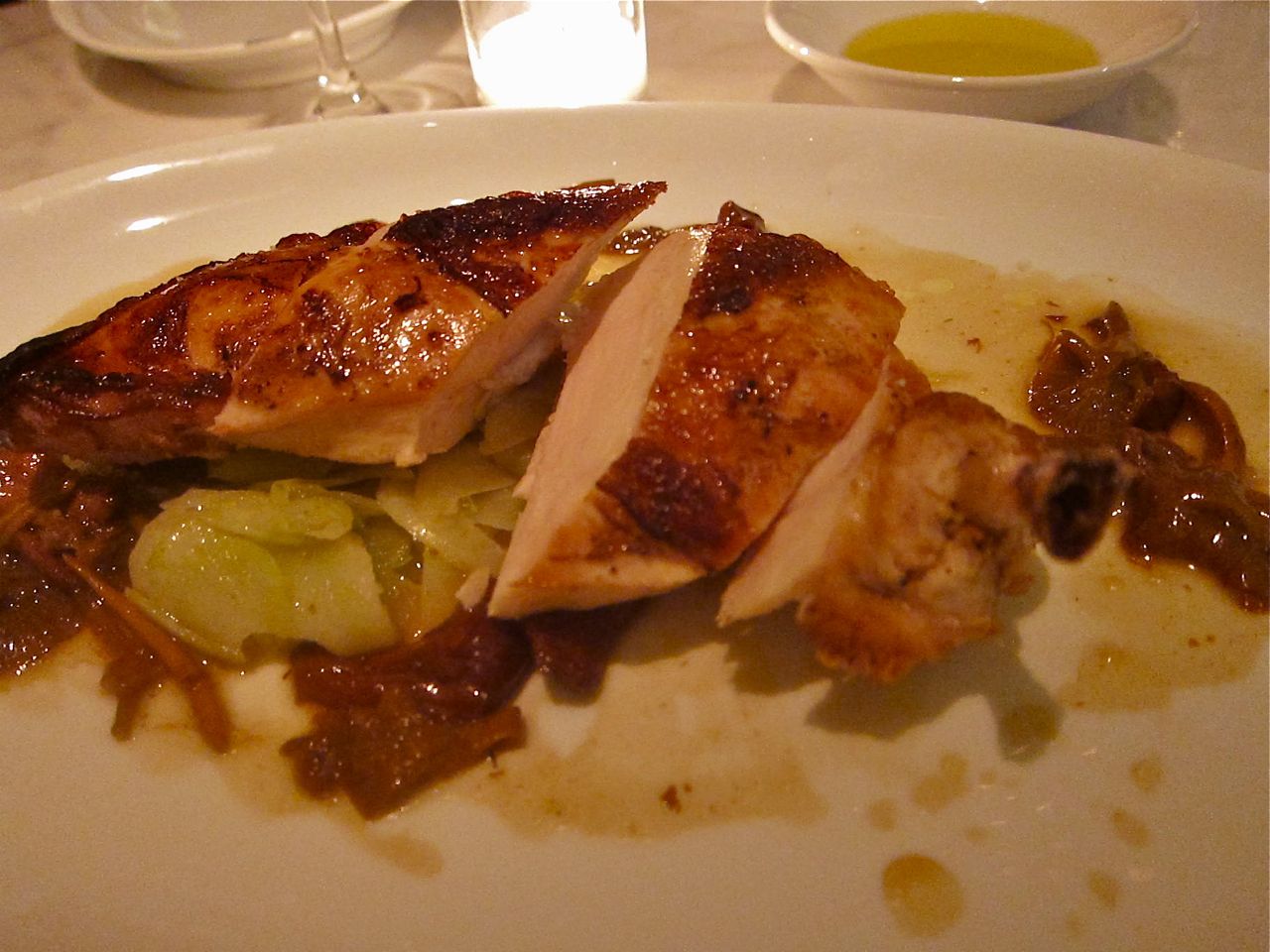
It’s rare to find a chicken breast that’s not overcooked. This isn’t it. Photo: Gael Greene
It is almost 11 and the room is emptying. “Is it too late for dinner?” a late-arriving twosome want to know. The chef staggers a little, clearly exhausted, as they are led to a table. I am contemplating the progress of civilization as expressed in “drunken prunes and crème fraiche.” I have vivid memories of that blissful marriage at Troisgros in Roanne a hundred years ago. Tonight it plays alongside a voluptuous chocolate budino, something between a pudding and a cake, melting at the core.
Now I am contemplating taking the Brussels sprouts home to cook them a little more. Our guest is contemplating the tragedy of leaving a third of the budino on the plate vs. depositing it directly on her hips. And she is plotting her next dinner here.
At New-York Historical Society,110 Central Park West, entrance on 77th Street. 212 485 9211. Lunch Monday through Saturday 11 to 3:30 pm. Brunch Sunday 11 am to 3:30 pm Mid-day Menu Daily 3:30 to 5 pm. Dinner Sunday through Thursday 5 to 10 pm. Friday and Saturday 5 to 11 pm.